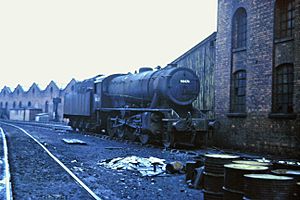BR ex-WD Austerity 2-8-0 facts for kids
Quick facts for kids BR ex-WD Austerity 2-8-0 |
|
 |
|
| 90474 at Woodford Halse, 1964 | |
| Power type | Steam |
|---|---|
| Designer | R.A. Riddles |
| Builder | |
| Build date | 1943–45 |
| Total production | 733 |
| Configuration | 2-8-0 |
| UIC classification | 1′D h2 |
| Gauge | 4 ft 8 1⁄2 in (1,435 mm) |
| Leading wheel diameter | 3 ft 2 in (965 mm) |
| Driver diameter | 4 ft 8+1⁄2 in (1,435 mm) |
| Length | 63 ft 6 in (19.35 m) over buffers |
| Axle load | 15 long tons 12 cwt (34,900 lb or 15.9 t) |
| Weight on drivers | 61 long tons 5 cwt (137,200 lb or 62.2 t) |
| Locomotive weight | 70 long tons 5 cwt (157,400 lb or 71.4 t) |
| Tender weight | 55 long tons 10 cwt (124,300 lb or 56.4 t) |
| Fuel type | Coal |
| Fuel capacity | 9 long tons 0 cwt (20,200 lb or 9.1 t) |
| Water capacity | 5,000 imperial gallons (23,000 L; 6,000 US gal) |
| Boiler pressure | 225 lbf/in2 (1.55 MPa) |
| Fire grate area | 28.6 sq ft (2.66 m2) |
| Heating surface: Tubes | 1,068 sq ft (99.2 m2) |
| Heating surface: Flues | 451 sq ft (41.9 m2) |
| Heating surface: Firebox | 168 sq ft (15.6 m2) |
| Superheater type | 28-element Melesco |
| Superheater area | 298 sq ft (27.7 m2) |
| Cylinders | Two, outside |
| Cylinder size | 19 in × 28 in (483 mm × 711 mm) |
| Valve gear | Walschaerts |
| Valve type | 10-inch (250 mm) piston valves |
| Tractive effort | 34,215 lbf (152.20 kN) |
| Power class | 8F |
| Axle load class | Route availability 6 |
| Withdrawn | 1959-1967 |
| Disposition | All scrapped. |
The BR ex-WD Austerity 2-8-0 was a type of steam locomotive used by British Railways (BR). These powerful engines were built for heavy freight trains. The "2-8-0" in their name describes their wheel arrangement: two small wheels at the front, eight large driving wheels in the middle, and no wheels at the back.
These locomotives were first built between 1943 and 1945 by the War Department. They were needed during World War II. After the war, many of them were no longer needed by the military.
In 1946, the LNER bought 200 of these locomotives. They also borrowed another 278. When British Railways was formed in 1948, it bought even more. In total, BR owned 733 of these locomotives. They were given new numbers, from 90000 to 90732.
Contents
What's in a Name?
One special locomotive, number 90732, was given the name Vulcan. It was named after the Vulcan Foundry, one of the companies that helped build these engines.
How They Were Used
These locomotives were mostly used for pulling heavy freight trains. It was quite rare to see them pulling passenger trains.
Most of these engines worked on the former LNER railway lines. This included areas from East Anglia all the way up to Scotland. Many were also found in the Lancashire & Yorkshire railway depots. Some were briefly used in the south of England before moving elsewhere. A smaller group worked in the west of England. The Scottish engines later spread out across the whole region.
Railway Incidents
- On January 16, 1958, locomotive 90277 was involved in an accident. It was standing too close to the main line at Preston. A passenger train crashed into it because of a signalman's mistake. The passenger train went off the tracks, and 90277 fell onto its side. Luckily, no one was seriously hurt, but thirteen people had minor injuries.
When They Stopped Working
These locomotives were taken out of service between 1959 and 1967. This process is called "withdrawal." Here's a quick look at how many were withdrawn each year:
| Year | Number Withdrawn | Example Numbers |
|---|---|---|
| 1959 | 1 | 90083 |
| 1960 | 2 | 90062 etc. |
| 1961 | 0 | |
| 1962 | 80 | |
| 1963 | 97 | |
| 1964 | 125 | |
| 1965 | 201 | |
| 1966 | 104 | |
| 1967 | 123 |
Preserved Locomotives
None of the specific BR Austerity 2-8-0 locomotives were saved. However, one of the original Austerity 2-8-0 engines did survive! This engine, originally WD No. 79257, traveled through the Netherlands and Sweden. It has since returned to Britain.
It has been restored to look like it did when it was new. It was even given the "BR number" 90733, even though it was never actually a BR engine. You can find this preserved locomotive at the Keighley and Worth Valley Railway.
See also


